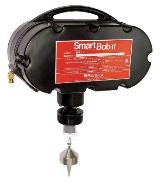The BinMaster SmartBob AO level sensor with integrated 4-20 mA analog output has received hazardous location certification. It is listed for Class II, Groups E, F, & G and enclosure types NEMA 4X, 5 and 12, ensuring the sensor is safe to use in locations where combustible dust may be present. This continuous level sensor works like an automated tape measure, but eliminates the needs to climb bins for manual measurements to reduce risk in the workplace.

The SmartBob AO with built-in 4-20 mA output is designed for facilities that prefer an analog output for monitoring bin level measurement data. The programming interface and controls are built in to the SmartBob AO circuit board for easy programming. Since the SmartBob AO measurement data is sent directly to a PLC, it provides an alternative to using a console or software for accessing measurement levels.
A simple push-button user interface built into the SmartBob AO circuitry is used to configure the settings for each SmartBob AO sensor. To set up the SmartBob AO, the user opens the device to access the keypad and steps through a series of push-button settings to set the interval timer, units of measure, 4 mA and 20 mA drop distances, maximum drop distance, and the Relay 1 and 2 functions. Once setup is complete, measurement data is sent directly to a PLC, with all settings for the bin saved in the non-volatile memory of the SmartBob AO.
An interval timer setting initiates a measurement in pre-determined time intervals such as every two, four or eight hours. When a measurement is needed immediately, an external start input can be used to initiate a measurement on demand. Additionally, an override input feature can be used to turn the measurement feature off, disabling the measurement function. The override feature is useful when filling tanks to avoid covering the SmartBob probe with material or to stop measurements when a bin is undergoing maintenance or cleaning.
The SmartBob AO features two relays that are configurable by the user, unlike competitive products that only have one relay, making the SmartBob AO more flexible and providing more data to the end user. The user simply selects any two of four different relay options in any combination including measurement status (measurement in process), high level alarm, low level alarm or error alarm (sensor did not take a measurement). Other benefits of the SmartBob AO include the output of a 22 mA error signal if the SmartBob AO should encounter a “stuck top” or “stuck bottom” condition and a soft start feature that reduces wear on the motor.